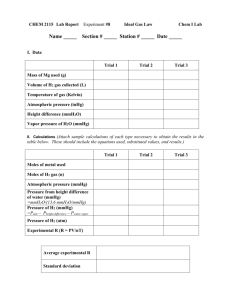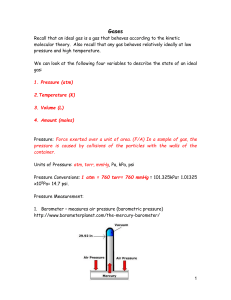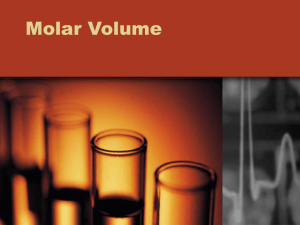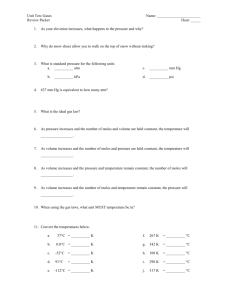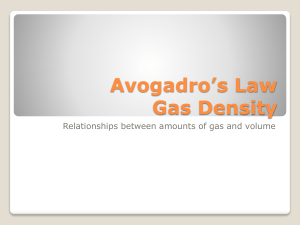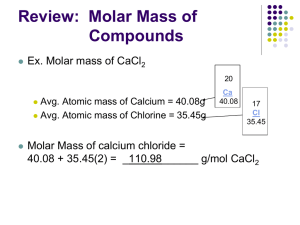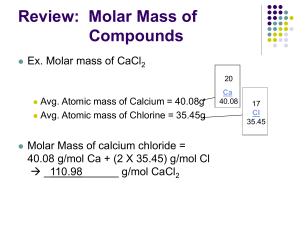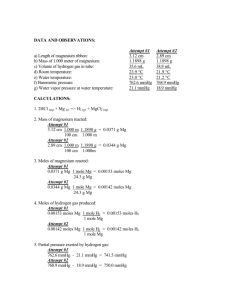Molar Volume of Hydrogen Lab Report: Experiment & Analysis
advertisement
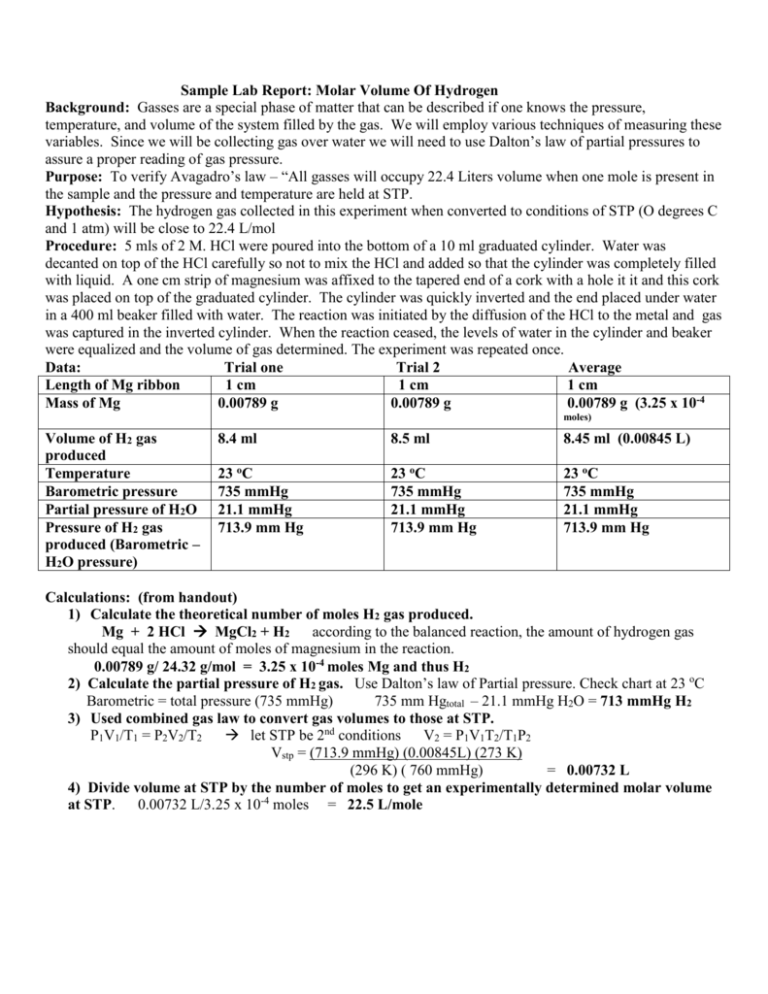
Sample Lab Report: Molar Volume Of Hydrogen Background: Gasses are a special phase of matter that can be described if one knows the pressure, temperature, and volume of the system filled by the gas. We will employ various techniques of measuring these variables. Since we will be collecting gas over water we will need to use Dalton’s law of partial pressures to assure a proper reading of gas pressure. Purpose: To verify Avagadro’s law – “All gasses will occupy 22.4 Liters volume when one mole is present in the sample and the pressure and temperature are held at STP. Hypothesis: The hydrogen gas collected in this experiment when converted to conditions of STP (O degrees C and 1 atm) will be close to 22.4 L/mol Procedure: 5 mls of 2 M. HCl were poured into the bottom of a 10 ml graduated cylinder. Water was decanted on top of the HCl carefully so not to mix the HCl and added so that the cylinder was completely filled with liquid. A one cm strip of magnesium was affixed to the tapered end of a cork with a hole it it and this cork was placed on top of the graduated cylinder. The cylinder was quickly inverted and the end placed under water in a 400 ml beaker filled with water. The reaction was initiated by the diffusion of the HCl to the metal and gas was captured in the inverted cylinder. When the reaction ceased, the levels of water in the cylinder and beaker were equalized and the volume of gas determined. The experiment was repeated once. Data: Trial one Trial 2 Average Length of Mg ribbon 1 cm 1 cm 1 cm Mass of Mg 0.00789 g 0.00789 g 0.00789 g (3.25 x 10-4 moles) Volume of H2 gas produced Temperature Barometric pressure Partial pressure of H2O Pressure of H2 gas produced (Barometric – H2O pressure) 8.4 ml 8.5 ml 8.45 ml (0.00845 L) 23 oC 735 mmHg 21.1 mmHg 713.9 mm Hg 23 oC 735 mmHg 21.1 mmHg 713.9 mm Hg 23 oC 735 mmHg 21.1 mmHg 713.9 mm Hg Calculations: (from handout) 1) Calculate the theoretical number of moles H2 gas produced. Mg + 2 HCl MgCl2 + H2 according to the balanced reaction, the amount of hydrogen gas should equal the amount of moles of magnesium in the reaction. 0.00789 g/ 24.32 g/mol = 3.25 x 10-4 moles Mg and thus H2 2) Calculate the partial pressure of H2 gas. Use Dalton’s law of Partial pressure. Check chart at 23 oC Barometric = total pressure (735 mmHg) 735 mm Hgtotal – 21.1 mmHg H2O = 713 mmHg H2 3) Used combined gas law to convert gas volumes to those at STP. P1V1/T1 = P2V2/T2 let STP be 2nd conditions V2 = P1V1T2/T1P2 Vstp = (713.9 mmHg) (0.00845L) (273 K) (296 K) ( 760 mmHg) = 0.00732 L 4) Divide volume at STP by the number of moles to get an experimentally determined molar volume at STP. 0.00732 L/3.25 x 10-4 moles = 22.5 L/mole 5) Calculate a percent error based on the experimental value and theoretical value. Percent error = | experimental – theoretical| Theorectical x 100% % error = 22.5 -22.4 L/mole/ 22.4 x 100 = 0.44% error This is a very small error. You must be a god of chemistry!!! Well, they do call Muse “Lord of the Ringstands” 6) Compare densities to published values: One mole x 2.02 g/mol 22.5 L = 0.0897 g/L published value = 0.0899 g/L Dang! Hydrogen is a really light gas. Perhaps that’s why they used it in Zeppelins And yes, it is way cheaper than helium. 7) In setting up the experiment a student noticed that a bubble of air leaked into the graduated cylinder when it was inverted. What effect would this have? Answer: The volume recorded would be too high and the estimate would be high. 8) A student noticed that the Mg ribbon was oxidized. What effect would this have? Answer: The MgO would react but not produce H2 gas. As a result the molar volume would be underestimated. 9) (Optional) The teacher wants to do this lab as a demo with a 50 ml graduated. What length of ribbon should be used. *assume Muse’s 0.00789 g/cm ribbon is used. Answer: You must produce less than 50 mls at the maximum room temperature of 30 oC in order to be able to measure the gas produced. If you plan to produce at 48 mls (allowing some wiggle room) you can plug into the Ideal gas law (PV =nRT) to determine the maximum moles. n = PV/RT n = (1 atm)(0.048L)/ (0.0821 atm*L/mol * K)(303 K) n = 0.00193 moles mass = moles * molar mass Length = grams grams /length 0.00193 moles * 24.31 = 0.0469 g 0.0469g/0.00789 g/cm = 5.94 cm

